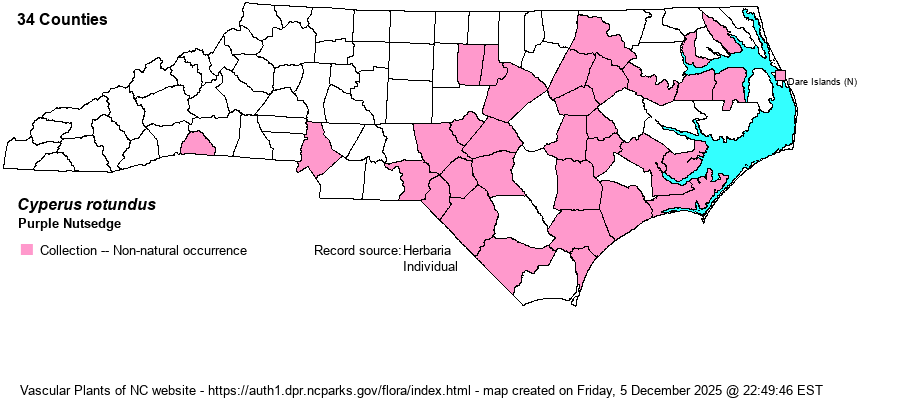| Author | L. | |
| Distribution | Mostly Coastal Plain (including Sandhills) and eastern Piedmont; also Mecklenburg and Polk counties.
Native to the tropics around the world; possibly native to the southernmost portions of N.A. | |
| Abundance | Uncommon in the Coastal Plain and lower Piedmont; rare westward. | |
| Habitat | Disturbed places such as lawns, roadsides, pastures, cultivated fields, etc. | |
| Phenology | Flowering and fruiting June-October. | |
| Identification | Purple Flatsedge grows from narrow, horizontal rhzomes; erect stems grow 9 inches to 2 feet tall. The inflorescence is branched and open, with open (not dense) spikes that are dull red and slender. | |
| Taxonomic Comments | The genus Cyperus is mostly tropical and warm-temperate in distribution; thus, in NC it is much commoner in the Coastal Plain than in the Mountains and Piedmont. Most species have 1-few flowering stems (culms) from grasslike basal leaves, plus a few stem leaves. At the summit is an inflorescence of very open and branched, or tightly packed, spikes, varying among species from brown to golden brown to straw-color to reddish. The arrangement of the spikelets is important, whether like a hand (digitate) or in paired or alternate rows (pinnate); as is the shape of the achene (seed), whether bi-convex in cross-section or triangular. As a group, Cyperus tends to be weedy and readily enters disturbed ground; this is true for many natives as well as all the aliens. In recent years, following DNA research, the genus has incorporated several genera that in RAB (1968) or other manuals were separate: Hemicarpha, Lipocarpha, and Kyllinga. | |
| Other Common Name(s) | | |
| State Rank | SE * | |
| Global Rank | G5 | |
| State Status | | |
| US Status | | |
| USACE-agcp | FAC link |
| USACE-emp | FAC link |

